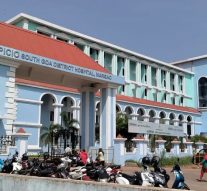Goa is abuzz with excitement as vintage bike and car owners, users, collectors and fans are decking […]

GOA’S HEALTH CARE MODEL NEEDS REVAMPING
LAW October 17, 2025By Dr Olav & Deborah Albuquerque
GOA’S pioneering pricing policy for expensive treatments like cancer and rare diseases, which allows for negotiated prices on drugs and equipment appears to be one of the best in the country. A proposal to ban private practice for government doctors earning over ₹10 lakh annually and the extension of OPD hours to improve access has allegedly not yet been announced. Nevertheless, Goa’s public health model, known as “The Goa Model” has gained recognition for its affordability and accessibility.
Despite this publicity for the Goa government, not all schemes are implemented with gusto. The Deen Dayal scheme where a card for the entire family of the bread winner is mandatory, is not being made expeditiously. Salcette residents complain that villagers from the surrounding villages have to make innumerable trips to the Mathany Saldanha Complex at Margao to make this health card. After the card is made, the government reimburses the cost of surgery at earmarked hospitals such as the South Goa District Hospital at Margao and other similar hospitals.
GOA is the first state to implement a pricing policy for expensive treatments, including cancer and rare diseases, aiming to make life-saving therapies more accessible by allowing the state to negotiate lower prices with manufacturers.
A proposal was made to ban government doctors with an annual income of over ₹10 lakh from engaging in private practice, emphasizing commitment to public healthcare. There are doctors employed in the Goa Medical College & Hospital as professors and who sometimes do have clinics where they treat patients. This is clearly a cardinal offence and strict action should be taken against such doctors.
IMPROVING HEALTHCARE
THE state plans to extend OPD hours to improve patient access to healthcare services. The state presented its public health model, which received international recognition for its focus on equitable and inclusive public health.
Project Parivartan is a four-year project aimed at reducing hospital-acquired infections and curbing antimicrobial resistance, which is being implemented in all 41 public health facilities, Health Minister Vishwajit Rane said on Wednesday, Oct 15. He held a detailed review meeting with representatives of Pfizer India, Americares India Foundation, the GMC dean, the director of DHS, and other senior representatives to assess the progress of the project.
The strategically designed intervention to address the growing threat of AMR and hospital-acquired infections is being implemented by GMC and the Directorate of Health Services in partnership with Americares India Foundation and supported by Pfizer’s corporate social responsibility (CSR) program. “Project Parivartan will help drive safer healthcare practices, improving patient outcomes and public health,” Rane said.
The project was launched on November 27, 2024 and a team of 19 professionals were trained. Stakeholder engagement meetings were held with officials from GMC, DHS and the hospital infection prevention and control committee at GMC. Ethical approvals were granted by the state ethical committee and the institutional ethical committee of GMC.
CONTAMINATED FISH
IN 2018, fish contaminated by the preservative formalin spread across Goa because in July 2018, officials from the Food & Drug Administration raided markets in south and north Goa, and picked up samples from 17 trucks carrying fish from Kerala, Tamil Nadu, Odisha, Andhra Pradesh and Karnataka. The samples included mackerel, sardines, rockfish, clams, ladyfish, prawns and white pomfret.
As fish traders protested, the then Agriculture Minister Vijai Sardesai tweeted that afternoon: “Any knee-jerk action aimed at creating panic is uncalled for…. Thankfully FDA has now confirmed that reports indicate fish showing no trace of formalin and hence #safe…” The FDA, however, issued a statement in the evening, saying the seized fish did indeed contain formalin — though “within permissible limits.”
It said the samples, brought to their lab on a “war footing,” had confirmed the presence of “formaldehyde,” a chemical which, in a compound with water and a stabiliser, is commonly referred to as formalin. The first reports of formalin-laced fish came from Kerala. On June 24-25, 2018 the Kerala Food Safety and Fisheries Departments in a joint raid, seized 9,600 kg of contaminated fish at Arayankavu in Kollam district. Separately, 6,000 kg of contaminated fish was seized at Walayar in Palakkad district. In Kanyakumari, Tamil Nadu officials have been carrying out raids almost every other day for the last two weeks, but laboratory tests have so far returned negative for formalin. Lajid K K, Assistant Director, Fisheries, Ernakulam, said the formalin scare is not a “new alert.”
Samples had been first picked up two years ago. “Consumers were approaching us, saying the fish didn’t smell and didn’t decompose even outside the fridge. There was even a complaint saying fish remained fresh on the dining table for two days,” Lajid said. Kerala, which consumes around 10,000 tonnes of fish every day, has been carrying out a storm of raids under its umbrella fish safety and hygiene campaign, Operation Sagar Rani. And the Kochi-based Central Institute of Fisheries Technology (CIFT) has now developed a detection kit for formalin — paper changes colour if rubbed on fish laced with the chemical — that is in use in several states.
A Kerala FDA official said fish trucks from Andhra Pradesh, which sometimes use fake Kerala registration plates, often contain a formalin-laced cargo. “They have to have ice and fish in the ratio of 1:1, but even then, the distance is long, and fish tends to spoil. Formalin helps delay decomposition,” the official said. According to officials across three states — Tamil Nadu, Kerala and Goa — aquaculture harvests from Andhra Pradesh tend to have the biggest chances of formalin contamination.
The offending chemical Formalin, is a preservative mostly used in forensic museums and morgues where autopsies are conducted. Dr Shailesh Mohite, forensic chief of Mumbai’s Nair Hospital, said formalin is used to harden human tissue for post mortem examinations. “It tightens the cellular architecture, and is used in forensic museums.
NO TO FORMALIN
IN morgues, we use formalin to ensure the specimen doesn’t decompose,” he said. Dr Mohite was clear that formalin “should never be consumed by humans.” Even in laboratories, he said, “we use only a 10% solution, so with 900 ml of water, we use 100 ml of the chemical.” Formalin could also be carcinogenic, doctors said. Pawan Kumar Agrawal, CEO of India’s food safety regulator, Food Safety and Standards Authority of India (FSSAI), said there were “no permissible limits for formalin,” thus refuting the Goa FDA’s claim. An FSSAI advisory clarified that “formaldehyde, the laboratory name for formalin, is not permitted for use in foods as per Food Safety and Standards Regulation, 2011.”
Ironically, the woman from the Goa FDA who shut down the Margao fish market, was suspended and she later approached the Goa Human Rights Commission. It is not known whether the two members, Desmond D’Costa and Pramod Kamath have delivered the judgment. Quite often, complaints have been made that they are not seriously interested in passing orders against the government.
(Dr Olav Albuquerque is a senior journalist-cum-advocate of the Bombay high court and an honorary member of the Goa Union of Journalists, while Deborah Albuquerque is a practising advocate.)















